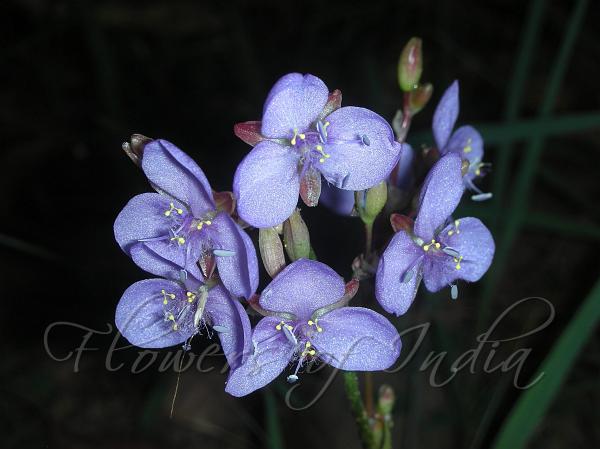|
| Edible Dewflower |
|

|

| File size | 377362 |
| Original date | 5/10/08 6:56 AM |
| Resolution | 2048 x 1536 |
| Flash | Flash fired |
| Focal length | 12.2mm |
| Exposure time | 1/120s |
| Aperture | 12.4 |
| Focus Distance | |
| Metering Mode | Multi-segment |
| Camera make | NIKON |
| Camera model | COOLPIX S6 |
| Sensor type |
|
|
|
|
Photo: |
Botanical name: Murdannia edulis Family: Commelinaceae (Dayflower family)
Synonyms: Commelina edulis, Murdannia scapiflora, Commelina scapiflora
Synonyms: Commelina edulis, Murdannia scapiflora, Commelina scapiflora
Edible Dewflower is a perennial herb with roots
fibrous, robust, up to more than 10 cm x 2--4 mm. Stems are several
from rosette, scape-like, nearly equaling the leaves, about 2 mm in
diameter, hairless to densely hairy. Leaves are all basal, in a
rosette. Leaves are linear, 10-42 x 2-4.5 cm, hairless or sparsely
hairy on both surfaces, margin frilly and often wavy, tip often
long-pointed. Cincinni are solitary in each involucral bract or
sometimes several in leaf axils, proximal cincinni to 3 cm, distal ones
gradually becoming smaller, apical ones about 2 mm. Involucral bracts
are sheathlike, rarely with blade, basal 1--3 often infertile, pedicels
5-8 mm in fruit, with sheathlike, membranous involucral bracts, forming
reduced inflorescence shoots. Sepals lanceolate, ca. 4 mm, persistent.
Petals are pink or purple, obovate-round. Fertile stamens are 3;
filaments velvety, staminodes 3; antherodes 3-sect. Capsule ellipsoid,
trigonous, ca. 7 mm. Seeds ca. 7 per valve, slightly flattened,
reticulate. Edible Dewflower is found in the Himalayan forests, near
sea level to 1000 m. Flowering: June-August.
| Identification credit: Krishan Lal | Photographed in Sirmaur Distt, Himachal Pradesh & Kaliyam forest, Jharkhand. |
• Is this flower misidentified? If yes,